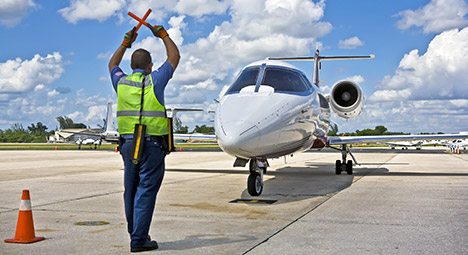

June 26, 2017
Improving the safety of business aircraft operations has been a top priority of NBAA ever since the association was founded, and the Safety Committee, formed in 1954, was one of NBAA’s first standing committees.
Starting in the early 1950s, NBAA presented flying safety awards to recognize member companies and individuals for achieving years of accident-free operations. The awards, which underscore the high level of professionalism in business aviation, have shone a spotlight on the industry’s outstanding safety record, which in recent years has approximated the safety record of the major airlines. Over the years, a significant number of NBAA members have flown without accidents or incidents for more than a half century.
Today, the more than 65 members of the Safety Committee continue to work to advance safety throughout the industry through a variety of initiatives. Each committee member brings a unique safety perspective to the group, which includes all types of business aircraft operators, from owner-pilots to flight department managers of companies large and small, to executives of aircraft management and charter companies. Other members hold safety management positions with aircraft training organizations, work for aircraft or component manufacturers, or are part of government oversight and regulatory organizations.

NBAA COO Steve Brown at the 2007 Safety Standdown Europe – a non-commercial effort by Bombardier, NBAA and the European Business Aviation Association – held at EBACE2007 in Geneva.
Studying the most effective ways to promote a safety-first corporate culture has been a common pursuit of these NBAA Safety Committee members, and in recent years the committee has published annually a list of top safety focus areas.
The current top issues of the Safety Committee include addressing:
- The single-pilot accident rate, which remains consistently higher than that of dual-pilot operations
- Inflight loss-of-control (LOC-I)
- Runway excursions
- Airport ground collisions
- Procedural non-compliance with regulations and standard operating procedures by aviation personnel
- Distractions from duty
- Scenario- and risk-based training and checking
- Airspace complexities
Recent Safety Committee actions include:
- Defining an NBAA five-year Strategic Safety Vision
- Engaging the business aviation community in the FAA’s Aviation Safety Information Analysis and Sharing program, and encouraging broad participation in safety data analysis and data-sharing programs
- Creating dedicated online resources for owner-pilots who fly solo
- Creating online resources, including training videos and a list of training providers, to help mitigate LOC-I
- Creating the Dr. Tony Kern Professionalism in Aviation Award to recognize individuals who exemplify professionalism in aviation
- Structuring the Safety Committee consistent with a safety management system model, and evolving its risk assessment process


 International Business Aviation Council Ltd.
International Business Aviation Council Ltd.